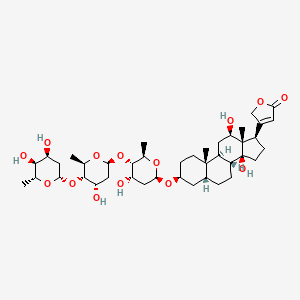D0884 | digoxin
C
C01AA05 Digoxin
[C01AA] Digitalis glycosides
[C01A] CARDIAC GLYCOSIDES
[C01] CARDIAC THERAPY
[C] Cardiovascular system
| Toxicity | Dose | Time | Species | Model | Method | Action | Positive criterion | Reference |
|---|---|---|---|---|---|---|---|---|
| MEMBRANE POTENTIAL | 0.52±0.09 | human | qHTS-HepG2 | MMP assay | decrease | IC50 | 163 | |
| MEMBRANE POTENTIAL | 0.13 | human | HepG2 | MMP assay | decrease | IC50 | 163 | |
| MEMBRANE POTENTIAL | rat | hepatocytes | MMP assay | Negative | IC50 | 163 | ||
| Pictogram | Signal | Statements | Precautionary Statement Codes |
|---|---|---|---|
    |
Danger |
Aggregated GHS information provided by 119 companies from 14 notifications to the ECHA C&L Inventory. Each notification may be associated with multiple companies. H300+H330 (31.93%): Fatal if swallowed or if inhaled [Danger Acute toxicity, oral acute toxicity, inhalation] H300 (85.71%): Fatal if swallowed [Danger Acute toxicity, oral] H319 (51.26%): Causes serious eye irritation [Warning Serious eye damage/eye irritation] H330 (81.51%): Fatal if inhaled [Danger Acute toxicity, inhalation] H331 (10.08%): Toxic if inhaled [Danger Acute toxicity, inhalation] H372 (43.7%): Causes damage to organs through prolonged or repeated exposure [Danger Specific target organ toxicity, repeated exposure] H400 (56.3%): Very toxic to aquatic life [Warning Hazardous to the aquatic environment, acute hazard] Information may vary between notifications depending on impurities, additives, and other factors. The percentage value in parenthesis indicates the notified classification ratio from companies that provide hazard codes. Only hazard codes with percentage values above 10% are shown. |
P260, P261, P264, P270, P271, P273, P280, P284, P301+P310, P304+P340, P305+P351+P338, P310, P311, P314, P320, P321, P330, P337+P313, P391, P403+P233, P405, and P501; (The corresponding statement to each P-code can be found at the GHS Classification page.) |
 |
Danger |
H300: Fatal if swallowed [Danger Acute toxicity, oral] H330: Fatal if inhaled [Danger Acute toxicity, inhalation] |
P260, P264, P270, P271, P284, P301+P310, P304+P340, P310, P320, P321, P330, P403+P233, P405, and P501; (The corresponding statement to each P-code can be found at the GHS Classification page.) |
| (3beta,5beta,12beta)-3-((O-2,6-Dideoxy-beta-D-ribo-hexapyranosyl-(1-4)-2,6-dideoxy-beta-D-ribo-hexopyranosyl-(1-4)-2,6-dideoxy-beta-D-ribo-hexopyranosyl)oxy)-12,14-dihydroxycard-20(22)-enolide | (3beta,5beta,12beta)-3-{[2,6-dideoxy-beta-D-ribo-hexopyranosyl-(1->4)-2,6-dideoxy-beta-D-ribo-hexopyranosyl-(1->4)-2,6-dideoxy-beta-D-ribo-hexopyranosyl]oxy}-12,14-dihydroxycard-20(22)-enolide | 0B9662A7-264E-4ACD-94B2-9E1138C0CA5A |
| 12bet.-Hydroxydigitoxin | 12beta-Hydroxydigitoxin | 20830-75-5 |
| 3-[(3S,5R,8R,9S,10S,12R,13S,14S,17R)-10,13-dimethyl-3-[(2R,4S,5S,6R)-6-methyl-5-[(2S,4S,5S,6R)-6-methyl-5-[(2S,4S,5S,6R)-6-methyl-4,5-bis(oxidanyl)oxan-2-yl]oxy-4-oxidanyl-oxan-2-yl]oxy-4-oxidanyl-oxan-2-yl]oxy-12,14-bis(oxidanyl)-1,2,3,4,5,6,7,8,9,11,12, | 3-[(3S,5R,8R,9S,10S,12R,13S,14S,17R)-3-[(2R,4S,5S,6R)-5-[(2S,4S,5S,6R)-5-[(2S,4S,5S,6R)-4,5-dihydroxy-6-methyl-tetrahydropyran-2-yl]oxy-4-hydroxy-6-methyl-tetrahydropyran-2-yl]oxy-4-hydroxy-6-methyl-tetrahydropyran-2-yl]oxy-12,14-dihydroxy-10,13-dimethyl-1,2,3,4,5,6,7,8,9,11,12,15,16,17-tetradecahydrocyclopenta[a]phenanthren-17-yl]-2H-furan-5-one | 3-[(3S,5R,8R,9S,10S,12R,13S,14S,17R)-3-[(2R,4S,5S,6R)-5-[(2S,4S,5S,6R)-5-[(2S,4S,5S,6R)-4,5-dihydroxy-6-methyloxan-2-yl]oxy-4-hydroxy-6-methyloxan-2-yl]oxy-4-hydroxy-6-methyloxan-2-yl]oxy-12,14-dihydr |
| 3-[(3S,5R,8R,9S,10S,12R,13S,14S,17R)-3-[(2R,4S,5S,6R)-5-[(2S,4S,5S,6R)-5-[(2S,4S,5S,6R)-4,5-dihydroxy-6-methyloxan-2-yl]oxy-4-hydroxy-6-methyloxan-2-yl]oxy-4-hydroxy-6-methyloxan-2-yl]oxy-12,14-dihydroxy-10,13-dimethyl-1,2,3,4,5,6,7,8,9,11,12,15,16,17-tetradecahydrocyclopenta[a]phenanthren-17-yl]-2H-furan-5-one | 3-[(3S,5R,8R,9S,10S,12R,13S,14S,17R)-3-[[(2R,4S,5S,6R)-5-[[(2S,4S,5S,6R)-5-[[(2S,4S,5S,6R)-4,5-dihydroxy-6-methyl-2-oxanyl]oxy]-4-hydroxy-6-methyl-2-oxanyl]oxy]-4-hydroxy-6-methyl-2-oxanyl]oxy]-12,14-dihydroxy-10,13-dimethyl-1,2,3,4,5,6,7,8,9,11,12,15,16, | 3b0w |
| 3beta,12beta,14-Trihydroxy-5beta,14beta-card-20(22)-enolid-3-tridigitoxosid | 3beta-((O-2,6-Dideoxy-beta-D-ribo-hexopyranosyl-(1-4)-O-2,6-dideoxy-beta-D-ribo-hexopyranosyl-(1-4)-2,6-dideoxy-beta-D-ribo-hexopyranosyl)oxy)-12beta,14-dihydroxy-5beta-card-20(22)-enolide | 4-((1S,2S,5S,11S,15S,7R,10R,14R,16R)-5-{5-[5-((2S,4S,5S,6R)-4,5-dihydroxy-6-me thyl(2H-3,4,5,6-tetrahydropyran-2-yloxy))(4S,5S,2R,6R)-4-hydroxy-6-methyl(2H-3 ,4,5,6-tetrahydropyran-2-yloxy)](4S,5S,2R, |
| 4-((1S,2S,5S,11S,15S,7R,10R,14R,16R)-5-{5-[5-((2S,4S,5S,6R)-4,5-dihydroxy-6-me thyl(2H-3,4,5,6-tetrahydropyran-2-yloxy))(4S,5S,2R,6R)-4-hydroxy-6-methyl(2H-3 ,4,5,6-tetrahydropyran-2-yloxy)](4S,5S,2R,6R)-4-hydroxy-6-methyl(2H-3,4,5,6-te trahydropyran-2-yl | 4-[(1S,2S,5S,7R,10R,11S,14R,15S,16R)-5-{[(2R,4S,5S,6R)-5-{[(2S,4S,5S,6R)-5-{[(2S,4S,5S,6R)-4,5-dihydroxy-6-methyloxan-2-yl]oxy}-4-hydroxy-6-methyloxan-2-yl]oxy}-4-hydroxy-6-methyloxan-2-yl]oxy}-11,16-dihydroxy-2,15-dimethyltetracyclo[8.7.0.0^{2,7}.0^{11,15}]heptadecan-14-yl]-2,5-dihydrofuran-2-one | 5-18-04-00381 (Beilstein Handbook Reference) |
| 6R)-4-hydroxy-6-methyl(2H-3,4,5,6-te trahydropyran-2-yloxy)}-11,16-dihydroxy-2,15-dimethyltetracyclo[8.7.0.0<2,7>.0 <11,15>]heptadec-14-yl)-5-hydrofuran-2-one | 73K4184T59 | 830D755 |
| A814956 | AKOS015895113 | AKOS024283494 |
| AS-13281 | Acygoxin | B7684 |
| BDBM46355 | BIDD:PXR0148 | BPBio1_000500 |
| BRD-K23478508-001-03-7 | BRN 0077011 | BSPBio_000454 |
| C-23516 | C06956 | C41H64O14 |
| CAS-20830-75-5 | CC-26802 | CCG-220437 |
| CHEBI:4551 | CHEMBL1751 | CS-4571 |
| Card-20(22)-enolide, 3-((O-2,6-dideoxy-beta-D-ribo-hexopyranosyl-(1-4)-O-2,6-dideoxy-beta-D-ribo-hexopyranosyl-(1-4)-2,6-dideoxy-beta-D-ribo-hexopyranosyl)oxy)-12,14-dihydroxy-, (3beta,5beta,12beta)- | Card-20(22)-enolide, 3-((O-2,6-dideoxy-beta-D-ribo-hexopyranosyl-(1->4)-O-2,6-dideoxy-beta-D-ribo-hexopyranosyl-(1->4)-2,6-dideoxy-beta-D-ribo-hexopyranosyl)oxy)-12,14-dihydroxy-, (3beta,5beta,12beta)- | Card-20(22)-enolide, 3-((O-2,6-dideoxy-beta-D-ribo-hexopyranosyl-(1.fwdarw.4)-O-2,6-dideoxy-beta-D-ribo-hexopyranosyl-(1.fwdarw.4)-2,6-dideoxy-beta-D-ribo-hexopyranosyl)oxy)-12,14-dihydroxy-, (3beta,5beta,12beta)- |
| Card-20(22)-enolide, 3-[[O-2,6-dideoxy-.beta.-D-ribo-hexopyranosyl-(1-->4)-O-2,6-dideoxy-.beta.-D-ribo-hexopyranosyl-(1-->4)-2,6-dideoxy-.beta.-D-ribo-hexopyranosyl]oxy]-12,14-dihydroxy-, (3.beta.,5.beta.,12.beta.)-; | Cardigox | Cardiogoxin |
| Cardioxin | Certified Reference Material | Chloroformic digitalin |
| Coragoxine | Cordioxil | D00298 |
| D1828 | DB00390 | DSSTox_CID_2934 |
| DSSTox_GSID_22934 | DSSTox_RID_76794 | DTXSID5022934 |
| Davoxin | Digacin | Digitek |
| Digoksyna | Digoksyna [Polish] | Digomal |
| Digon | Digonix | Digos |
| Digosin | Digossina | Digossina [DCIT] |
| Digoxigenin-tridigitoxosid | Digoxigenin-tridigitoxosid [German] | Digoxin (JP17/USP) |
| Digoxin 1.0 mg/ml in Methanol | Digoxin Nativelle | Digoxin Pediatric |
| Digoxin [USP:INN:BAN:JAN] | Digoxin for peak identification, European Pharmacopoeia (EP) Reference Standard | Digoxin solution, 1.0 mg/mL in methanol, ampule of 1 mL, certified reference material |
| Digoxin, 95% | Digoxin, European Pharmacopoeia (EP) Reference Standard | Digoxin, Pharmaceutical Secondary Standard |
| Digoxin, United States Pharmacopeia (USP) Reference Standard | Digoxin, analytical standard | Digoxin, certified reference material, TraceCERT(R) |
| Digoxin-Sandoz | Digoxin-Zori | Digoxina |
| Digoxina [INN-Spanish] | Digoxina-Sandoz | Digoxine |
| Digoxine Navtivelle | Digoxinum | Digoxinum [INN-Latin] |
| Dilanacin | Dimecip | Dixina |
| Dokim | Dynamos | EINECS 244-068-1 |
| Epitope ID:122964 | Eudigox | Fargoxin |
| GTPL4725 | GTPL4726 | Grexin |
| H797 | HMS1569G16 | HMS2096G16 |
| HMS2232G20 | HMS3713G16 | HSDB 214 |
| HY-B1049 | Hemigoxine Nativelle | Homolle's digitalin |
| J-013666 | J10027 | LANOXIN PEDIATRIC |
| LTMHDMANZUZIPE-PUGKRICDSA-N | Lanacordin | Lanacrist |
| Lanicor | Lanikor | Lanorale |
| Lanoxicaps | Lanoxicaps (TN) | Lanoxin |
| Lanoxin (TN) | Lanoxin PG | Lenoxicaps |
| Lenoxin | Lifusin | MCULE-8165628529 |
| MFCD00003674 | MLS000069819 | MLS001055371 |
| MLS001076495 | Mapluxin | NCGC00090797-01 |
| NCGC00090797-02 | NCGC00090797-03 | NCGC00090797-04 |
| NCGC00090797-05 | NCGC00090797-06 | NCGC00090797-07 |
| NCGC00090797-09 | NCGC00090797-15 | NCGC00257022-01 |
| NCGC00259227-01 | NSC 95100 | NSC-95100 |
| Natigoxin | Neo-Lanicor | Neodioxanin |
| Novodigal [inj.] | Opera_ID_1134 | Prestwick0_000437 |
| Prestwick1_000437 | Prestwick2_000437 | Prestwick3_000437 |
| Prestwick_170 | Purgoxin | Q422222 |
| REGID_for_CID_2724385 | Rougoxin | SCHEMBL20506 |
| SK-Digoxin | SMR000059217 | SMR000653537 |
| SPBio_002393 | SR-01000721866 | SR-01000721866-3 |
| SR-01000721866-4 | ST069334 | Saroxin |
| Tox21_111025 | Tox21_201678 | Tox21_303050 |
| UNII-73K4184T59 | Vanoxin | ZINC242548690 |
| ZX-AFC001295 | [3H]-digoxin | [3H]digoxin |
| cid_2724385 | digoxin | oxy-10,13-dimethyl-1,2,3,4,5,6,7,8,9,11,12,15,16,17-tetradecahydrocyclopenta[a]phenanthren-17-yl]-2H-furan-5-one |
| s4290 |

